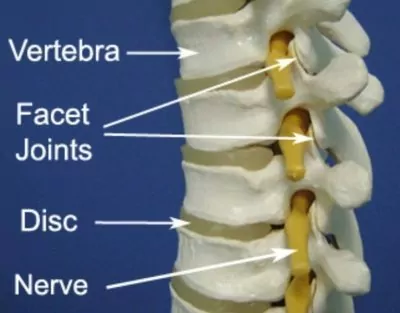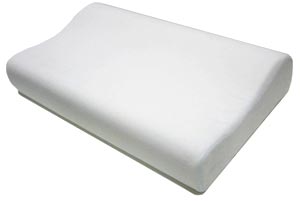T4 Syndrome
Updated:
What is T4 syndrome?
The upper back (thoracic spine) comprises of many bones known as vertebrae. There are 12 thoracic vertebrae named T1 to T12 from the top of the upper back to the bottom of the upper back. Each of these vertebrae connects with the vertebra above and below via two types of joints: the facet joints on either side of the spine and the discs centrally (figure 1). These joints are designed to support body weight and enable spinal movement. In close proximity to these joints are nerves, which can be damaged or irritated upon injury to either the disc or the facet joint at a particular level (figure 1).

During certain movements of the spine, stretching or compressive forces are placed on the facet joints and discs at the T4 level. If these forces are excessive and beyond what the joints can withstand, injury to the facet joints or discs may occur. When this results in irritation or damage to the adjacent nerves at the T4 level and the patient experiences symptoms such as diffuse arm pain, pins and needles or numbness in the hands, headaches and often upper back or neck pain or stiffness, the condition is known as T4 syndrome.
Causes of T4 syndrome
T4 syndrome typically occurs due to injury to the facet joints or disc at T4 which then affects the nerve root at that level. Injury to these structures can occur during excessive bending, lifting, arching, or twisting movements or due to poor posture. This may occur traumatically or due to repetitive or prolonged forces.
Signs and symptoms of T4 syndrome
Patients with this condition usually experience diffuse arm pain and sensory symptoms such as pins and needles or numbness in the hands. Headaches may also be experienced in addition to pain or stiffness in the upper back and occasionally, the neck.
Symptoms may develop suddenly during the causative activity, however, it is also common for patients to experience pain and stiffness after the provocative activity, particularly the next morning. Symptoms are typically felt in one arm or on one side of the upper back although occasionally both sides may be affected. Pain may also be referred into the shoulder blade, ribs and chest. Muscle spasm, stiffness and restricted spinal movement may also be experienced, particularly around the affected joint. Symptoms are generally exacerbated with activities that involve twisting, lifting, arching backwards, bending forwards or sideways, sitting for prolonged periods of time, coughing or sneezing, or performing activities that involve using the hands in front of the body such as driving or ironing.
Diagnosis of T4 syndrome
A thorough subjective and objective examination from a physiotherapist is usually sufficient to diagnose T4 syndrome. Investigations such as an MRI or CT scan may be required to confirm diagnosis.
Treatment for T4 syndrome

Members Only ContentBecome a PhysioAdvisor Member to gain full access to this exclusive content. For more details see Become a Member. Already a member? Login Now
Prognosis of T4 syndrome
The recovery time for patients with T4 syndrome may vary from case to case depending on a variety of factors such as the severity of injury and compliance with physiotherapy advice. With ideal treatment, patients may be pain free in as little as several days, although typically this may take 2 – 3 weeks. It is important to note, however, that injured tissue takes approximately six weeks to restore the majority of its strength in ideal healing conditions. Care must therefore be taken when returning to activity during this period. In severe cases or in those patients who do not rest adequately from aggravating activities, symptoms may persist for many months or even years.
Physiotherapy for T4 syndrome
Physiotherapy for patients with this condition can hasten the healing process, ensure an optimal outcome, and reduce the likelihood of future recurrence. Treatment may involve:
- soft tissue massage
- mobilization
- manipulation
- electrotherapy (e.g. ultrasound)
- postural taping or bracing
- dry needling
- education
- activity modification advice
- ergonomic advice
- the use of a lumbar support for sitting
- Clinical Pilates
- hydrotherapy
- exercises to improve flexibility, strength, posture and core stability
- a gradual return to activity program
Contributing factors to the development of T4 syndrome
There are several factors that may contribute to the development of T4 syndrome. These factors need to be assessed and corrected with direction from a physiotherapist and may include:
- poor posture
- thoracic spine stiffness
- a sedentary lifestyle
- poor core stability
- muscle weakness or tightness
- inappropriate lifting technique
- a lifestyle involving large amounts of sitting, bending, lifting or activities involving the use of hands in front of the body
Other intervention for T4 syndrome
Despite appropriate physiotherapy management, a small percentage of patients with T4 syndrome fail to improve and may require other intervention. This may include pharmaceutical intervention, investigations such as an X-ray, CT scan or MRI, or assessment from a specialist. A corticosteroid injection into the joints of T4 may sometimes be used to help alleviate symptoms. The treating physiotherapist can advise on appropriate management and can refer to the appropriate medical authority if it is warranted clinically.
Exercises for T4 syndrome
The following exercises are commonly prescribed to patients with this condition. You should discuss the suitability of these exercises with your physiotherapist prior to beginning them. Generally, they should be performed provided they do not cause or increase symptoms.
Your physiotherapist can advise when it is appropriate to begin the ‘Initial Exercises’ and eventually progress to the ‘Intermediate’, ‘Advanced’ and ‘Other’ exercises. As a general rule, addition of exercises or progression to more advanced exercises should take place provided there is no increase in symptoms.
Initial Exercises
Shoulder Blade Squeezes
Begin sitting or standing tall with your back straight. Squeeze your shoulder blades together as hard and as far as possible without pain (Figure 3). Hold for 5 seconds and perform 10 repetitions provided the exercise does not cause or increase symptoms. Repeat 5 times daily.

Chin Tucks
Begin sitting or standing tall with your back and neck straight, shoulders should be back slightly. Tuck your chin in until you feel a mild to moderate stretch without pain (figure 4). Keep your eyes and nose facing forwards. Hold for 2 seconds and perform 10 repetitions provided the exercise does not cause or increase symptoms. Repeat 5 times daily.

Intermediate Exercises

Members Only ContentBecome a PhysioAdvisor Member to gain full access to this exclusive content. For more details see Become a Member. Already a member? Login Now
Advanced Exercises

Members Only ContentBecome a PhysioAdvisor Member to gain full access to this exclusive content. For more details see Become a Member. Already a member? Login Now
Other Exercises

Members Only ContentBecome a PhysioAdvisor Member to gain full access to this exclusive content. For more details see Become a Member. Already a member? Login Now
Rehabilitation Protocol for T4 Syndrome

Members Only ContentBecome a PhysioAdvisor Member to gain full access to this exclusive content. For more details see Become a Member. Already a member? Login Now
 Find a Physio
Find a Physio
Find a Physiotherapist in your local area who can treat T4 syndrome.
 Physiotherapy Products for T4 syndrome
Physiotherapy Products for T4 syndrome
Some of the most commonly recommended products by physiotherapists to hasten healing and speed recovery in patients with this condition include:
-
 Wheat Bags
Wheat Bags -
 OPPO – Posture Aid / Clavicle Brace (OPP2075)
OPPO – Posture Aid / Clavicle Brace (OPP2075) -
 AllCare Band
AllCare Band -
 Fitness Ball Pro – Loumet
Fitness Ball Pro – Loumet -
 Premium Strapping Tape 38mm (Victor)
Premium Strapping Tape 38mm (Victor) -
 AllCare Pro-TENS Machine
AllCare Pro-TENS Machine -
 AllCare Tubing
AllCare Tubing -
 AllCare Spikey Massage Ball
AllCare Spikey Massage Ball -
 Fixomull Stretch 5cm x 10m
Fixomull Stretch 5cm x 10m -
 AllCare Instant Cold Pack (15 x 25cm)
AllCare Instant Cold Pack (15 x 25cm) -
 AllCare Foam Roller Round
AllCare Foam Roller Round -
 Dentons Impressions Classic Memory Foam Therapeutic Pillow
Dentons Impressions Classic Memory Foam Therapeutic Pillow -
 Lumbar Rolls (‘D’ Shaped)
Lumbar Rolls (‘D’ Shaped)
To purchase physiotherapy products for T4 syndrome click on one of the above links or visit the PhysioAdvisor Shop.
 More Exercises
More Exercises
- Upper Back Flexibility Exercises.
- Upper Back Strengthening Exercises.
- Pilates Exercises.
- Postural Exercises
 More Information
More Information
- Postural Taping.
- Ergonomic Computer Setup.
- Mobile Phone Ergonomics.
- Posture.
- Why is my Injury Not Improving?
- Upper Back and Chest Pain Diagnosis Guide
Become a PhysioAdvisor Member

Link to this Page
If you would like to link to this article on your website, simply copy the code below and add it to your page:
<a href="https://physioadvisor.com.au/injuries/upper-back-chest/t4-syndrome”>T4 Syndrome – PhysioAdvisor.com</a><br/>PhysioAdvisor offers detailed physiotherapy information on T4 syndrome including: symptoms, causes, diagnosis, treatment, exercises, physiotherapy products and more...
Return to the top of T4 Syndrome.

